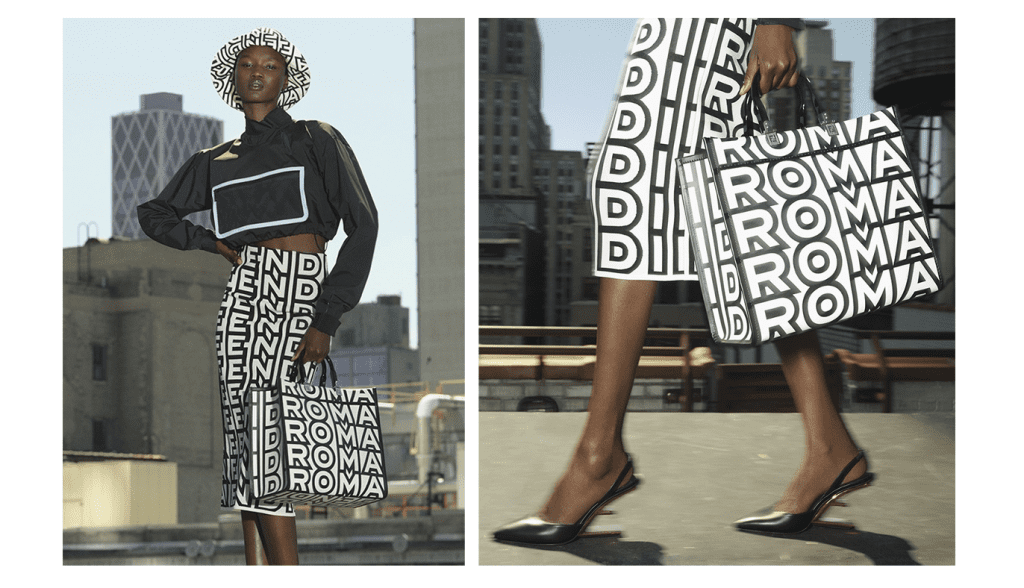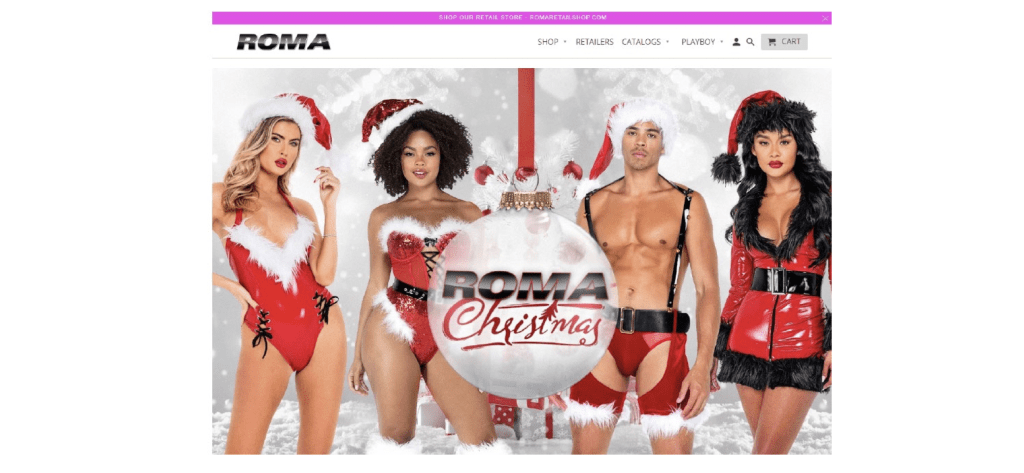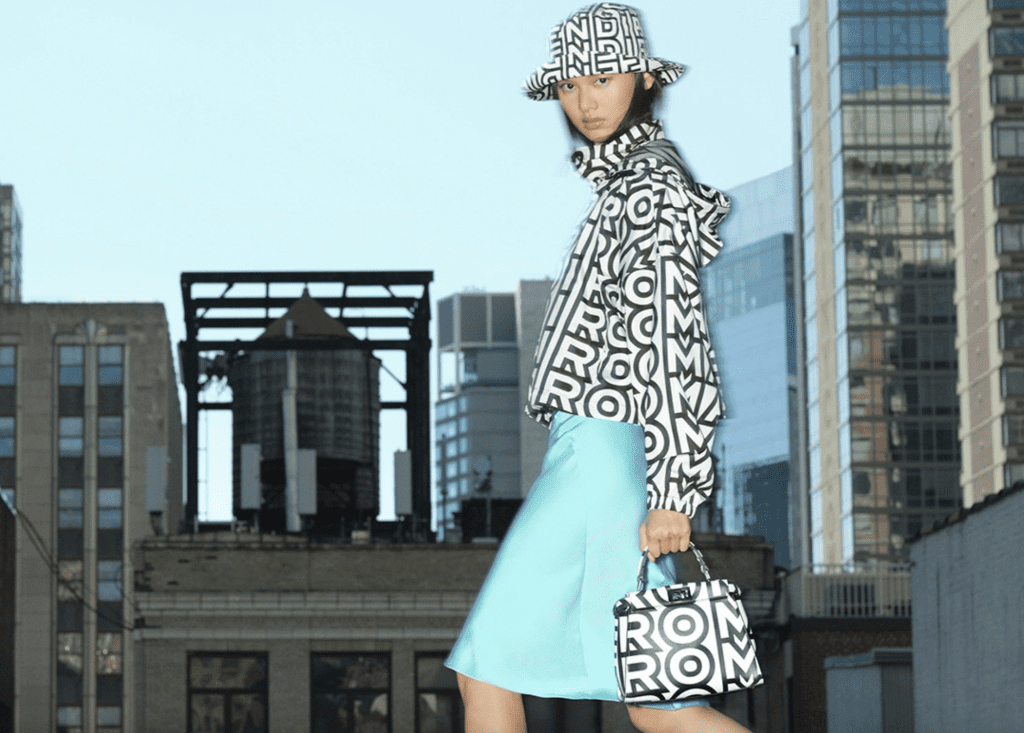Marc Jacobs is pushing back against the trademark infringement and unfair competition lawsuit that Roma Costume waged against it and fellow LVMH-owned brand Fendi in December for allegedly using a “reimagined” version of Fendi’s “Roma” logo that is “confusingly similar” to its own Roma trademark. In addition to denying Roma’s claims, Marc Jacobs sets out almost a dozen counterclaims, arguing that, among other things, the Los Angeles-based clothing, accessories, and costume design and manufacturing company waited too long to file suit, that its use of the Roma mark amounts to fair use, and that there is little (if any) likelihood that consumers will be confused between the parties’ use of the Roma mark.
In its Feb. 16 filing with the U.S. District Court for the Central District of California, Marc Jacobs (“MJ”) denies the bulk of Roma Costume’s claims, asserting that it has not engaged in infringement by way of its use of the Roma logo across an array of garments and accessories, and sets out nine affirmative defenses, including …
Laches + Statute of Limitations – MJ asserts that Roma Costume “knew or reasonably should have known about Fendi S.r.l.’s and Fendi North America’s use of the term ‘Roma’” in the U.S. – which dates back to the 1970s – “long before it filed this lawsuit.” By failing to take action until 2022, MJ argues that Roma engaged in an “unreasonable delay,” and thus, its claims are now “barred by laches.” Similarly, MJ claims that Roma failed to initiate its action within the relevant statutes of limitation, namely, four years under California law for trademark claims and for violations of Cal. Bus. & Prof. Code.
Statutory Fair Use + Ornamental Use – Here, MJ contends that it has not used “Roma” in a trademark capacity, and instead, uses the word to “serve an ornamental purpose” to “describe the origin of the Fendi company and its goods.” Accordingly, Roma’s claims are “barred by statutory fair use.” MJ also argues in separate defense that “the use of ‘Roma’ is merely ornamental and does not distinguish or indicate the source of the goods.”
(I think this is a pretty convincing argument in light of the fact that the word “Roma” takes the form of an all-over print on the Fendi/Marc Jacobs garments and accessories at issue, as opposed to embodying the more traditional placement of marks on such goods, including “discrete wording or design on the pocket or breast portion of a shirt,” “a tag on the inside of a hat or garment,” and/or a “logo on a tag above the back pocket of a pair of jeans.” These are some of the examples that the U.S. Patent and Trademark Office (“USPTO”) lists as “proper non-ornamental use[s] of a mark.”
As for ornamental uses, a USPTO examiner stated in an unrelated trademark proceeding that the “size, location, dominance, and significance of an alleged mark” is taken into consideration when determining if use is ornamental, asserting that “with respect to clothing,” for example, consumers “may recognize” certain placements of “small designs or discrete wording as trademarks, rather than as merely ornamental features,” as opposed to the use of words “located directly on the upper-center area of the front of [a] shirt and the front portion of [a] hat, where ornamental elements often appear.”)

No Likelihood of Confusion – MJ devotes the bulk of its affirmative defense arguments to its assertion that its use of “Roma” is not likely to cause confusion. Doing a little run-through of a number of the Sleekcraft factors, MJ argues that …
(1) Similarity of the Marks: The parties’ marks are different, per MJ, as Roma’s asserted mark is ROMA, while the “accused products display the accused term ‘Roma’ as ‘Fendi Roma,’ which includes the well- known and distinctive FENDI trademark.”
(2) Strength of the Mark: Roma’s asserted trademark is “weak and entitled to a narrow scope of protection,” per MJ, which claims that “multiple third-party goods are sold under the mark ‘ROMA’ or its equivalent, ‘ROME.’”
(3) Type/Proximity of the Goods: The parties’ goods are also different, according to MJ. “The accused products are expensive, high fashion luxury goods from a famous designer fashion house based in Rome, Italy.” On the other hand, Roma “sells inexpensive lingerie, clubbing outfits, and risqué Christmas and Halloween-themed costumes.”
(4) Channels of Trade: MJ and Fendi’s allegedly infringing products are “available only through authorized trade channels, including Fendi boutiques and high-end department stores,” and are “marketed in fashion shows with high-fashion talent.” In contrast, Roma’s products are “available only through adult-themed stores, such as Lover’s Lane.”

(5) Consumer’s Degree of Care: “The products’ purchasers differ,” MJ asserts, stating that the accused products “are expensive, and their purchasers are highly sophisticated and take significant care in making their purchases.” Such consumers are “not likely to be confused as to the source or affiliation of the goods.” At the same time, MJ maintains that Roma’s goods are “inexpensive and target a different audience.” (I would also argue that the buyers are fundamentally different in that Roma’s operations are aimed at wholesale buyers, with its website lacking traditional B2C e-commerce capabilities, thereby, distinguishing it from the defendants and the consumer-facing channels in which they primarily operate.)
(6) Intent – Finally, MJ asserts that it “had no knowledge prior to this lawsuit of [Roma] or its ROMA mark,” and “had no intent to confuse consumers as to the source of the accused goods or as to any affiliation with” Roma or its goods.
Not Unlawful, Unfair or Not Fraudulent – MJ argues that Roma’s complaint is barred, in whole or in part, because its “alleged practices referenced in the complaint” are not “unfair,” “unlawful,” or “fraudulent” within the meaning of California Business & Professions Code s. 17200.
Failure to State a Claim – Finally, MJ contends that Roma has “failed to state a claim upon which relief can be granted,” as there are “no factual allegations in the complaint that [it] aided and abetted infringing, conspired to infringe, or directly infringed [Roma’s] trademarks.”
Marc Jacobs’ answer comes in the wake of the complaint that Roma Costume filed late last year, in which it claims that “sometime before December 2022,” Fendi and Marc Jacobs “purportedly reimagined” Fendi’s existing “Roma logo,” which consists of “the stylized wording ‘FENDI’ in larger size font stacked on top of ‘ROMA’ with the wording appearing bigger in the middle than on the sides.” Notwithstanding its “established rights in the ROMA mark,” Roma Costume alleges that the defendants’ new iteration of the Fendi mark puts “ROMA” at the “center” of Fendi’s offerings – from $2,800-plus ROMA-emblazoned handbags and bucket hats to $1,400 dresses and jackets.
With this in mind and given that Fendi and Marc Jacobs’ use of the Fendi Roma logo allegedly “has caused and is likely to continue to cause consumer confusion, reverse confusion, mistake, and/or deception,” Roma Costume sets of claims of trademark infringement and unfair competition, and is seeking injunctive relief, as well as monetary damages.
The case is Roma Costumes Inc, et al. v. Fendi North America, Inc. et al., 2:22-cv-09104 (C.D. Cal.)














